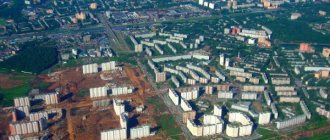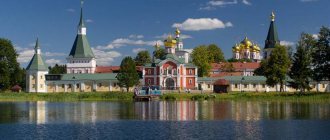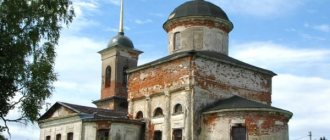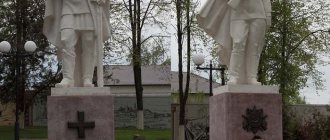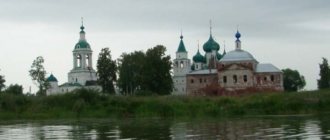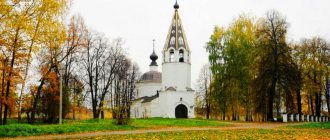Borovsk is a historical city in Russia, which is little explored by tourists. In its extraordinary landscapes and seemingly inconspicuous streets, the city preserves amazing architectural monuments, unique frescoes and the little-studied culture of the Old Believers. The mystery and deep history of Borovsk captivates and will not leave any visitor to this city indifferent.
The centuries-old history of Borovsk is simply fascinating. The exact designation of when the city was founded is still not known for certain, but ceramics were found , which dates back to the 11th - 13th centuries. The first mention of the city dates back to 1358. Surprisingly, Borovsk has managed to preserve not only its historical layout, but also its rich cultural heritage to this day. Thanks to this, he never tires of inspiring many artists and poets to create creative masterpieces.
Description and history of Borovsk
Borovsk is one of the oldest cities in Rus', which amazes with the number of attractions that have been preserved since the founding of the city.
It is located along the Protva River. Borovsk is the northernmost city of the Kaluga region, it is located 85 km from the southwestern region of Moscow, and 106 km from the regional center of Kaluga. The local population in 2022 was 10,734 people. The city abounds in coniferous trees and is surrounded on all sides by pine forests, which is why it is named “Borovsk”. The official founding date is considered to be 1358. This year Borovsk was mentioned in the chronicle of the prince, Ivan 2 Ivanovich the Red (Merciful), son of Ivan 1 Danilovich Kalita.
But there are 3 facts that cast doubt on the conclusion of historians:
- One of the ancient chronicles indicates the date of construction of the Church of the Intercession in Vysokoye Selo in 1146. At the same time, the baptism of the Slavs took place on the Protva River, and the Borovets (Borovsk) fortress was erected in the bend of the river.
- On the territory of Borovsk, during excavations, household items and ceramics were discovered dating back to an earlier period, the 11th – 13th centuries.
- The chronicle of Grand Duke Vasily Dmitrievich from 1390 speaks of the city of Borovsk as a fully formed appanage principality with an established internal order.
Historical events in Borovsk:
| 1378 | By decree of Prince Dmitry of Moscow, the city was transferred to Prince Vladimir of Serpukhov. |
| 1380 | Vladimir (Serpukhov-Borovsk prince) during the Tatar-Mongol attack sided with Prince Dmitry and played an important role in the Battle of Kulikovo. |
| 1480 | During the period of the “Great Standing on the Ugra” (the confrontation between Prince Ivan 3 of Moscow and Khan of the Great Horde Akhmat), Borovsk served as a defensive point on the southwestern borders of Moscow. |
| 1508 | During the Russian-Lithuanian War, Borovsk was transferred to the military leader and statesman Prince Mikhail Glinsky. |
| 1566 | Borovsk was transferred by Ivan the Terrible to Vladimir Staritsky. |
| 1600 – 1618 | In the "Time of Troubles", especially 1606 -1607. During the peasant war, Borovsk was severely destroyed. |
| 1634 | During a strong fire, the fortress was destroyed, which is why Borovsk lost its status as a defensive point and began to develop in trade. |
| 1666 | As a result of a split in the church, the sisters, noblewoman M.F. Morozova and princess E.P. Urusova, were exiled here. |
| 1777 | Approval of the city coat of arms of Borovsk. |
| 1812 | The city was ravaged and burned by Napoleon's retreating army. |
| 1860 | The famous thinker N. F. Fedorov lived and taught history in Borovsk. |
| 1880 – 1892 | The founder of astronautics, K. E. Tsiolkovsky, lived and taught mathematics in the city. His scientific works were written during the same period. |
| 1941 | The city was captured by the Nazis, its occupation lasted until January 4, 1942. |
Top 10 most interesting sights of Borovsk
Borovsk, whose sights are distinguished by their primitiveness and uniqueness, was included in the list of historical cities of Russia in 2000.
List of attractions:
- St. Pafnutev Borovsky Monastery. The monastery was founded by Saint Paphnutius, in worldly life Parthenius, who took monastic vows at the Vysoko-Pokrovsky Monastery in 1414. In 1444, Paphnutius and his disciple left the walls of the Intercession Monastery in search of solitude, but a string of like-minded people followed them. This is how a men’s monastery was formed called the Pafnutiev Monastery of the Nativity of the Blessed Virgin Mary. With donations from the clergy, the hermits built churches and temples. In the spring of 1477, the Monk Paphnutius died, he was canonized “as a saint,” and was buried near the main church of the monastery.
- Frescoes of Borovsk. A distinctive feature of Borovsk is the frescoes on the facades of ancient houses and fences. At the beginning of the 21st century, the artist, local historian and public figure V. A. Ovchinnikov moved from Moscow to Borovsk with his wife, poetess Elvira Chastikova. At some point, the artist decided to paint the dull walls of buildings, and his wife accompanied each drawing with a poem specially written for this illustration.
- Church of the Intercession of the Blessed Virgin Mary. The temple (or “Borovsk Kizhi”) is inextricably linked with the history of Paphnutius and the emergence of the Holy Paphnutian Monastery. It was in this temple that the Borovsk wonderworker Paphnutius served for 30 years (from 1414 to 1444). The Church of the Intercession of the Holy Virgin is made of wood without a single nail, but despite this, it has been perfectly preserved to this day, although usually such buildings require restoration after 200 years.
- Cathedral of the Annunciation of the Blessed Virgin Mary. The cathedral is located near the central square of the city on a hill above the Protva River. This is one of the oldest temples built of stone. The date of foundation of the cathedral is unknown for certain, but in ancient times the cathedral was made of wood. The cathedral is an important landmark of the city and is called the “Cathedral of the Kaluga-Borovsk diocese.”
- Temple of Boris and Gleb. 1 mention in the records of the “temple of Boris and Gleb” appeared in 1610. It was described that the wooden church burned out during a fire, and in 1621 it was restored. On the site of the wooden temple, a stone one was erected in 1704. The erected temple, erected in honor of the holy noble princes Boris and Gleb, is recognized as a monument of federal significance.
- Cathedral of the Intercession of the Blessed Virgin Mary. The official founding date of the church dates back to 1912. The Revolution of 17 did not make it possible to complete the interior decoration, and the cathedral was abandoned. In the 30s, due to its large area, the cathedral was used as a car garage and warehouses. Until the beginning of the 21st century, it was part of the Borovsk vehicle fleet. In the fall of 2005, it was decided to transfer the cathedral building to the Old Believers to house a nunnery there.
- Temple of Dmitry of Thessalonica. The Church of the Great Martyr Demetrius of Thessalonica is located in the village of Ryabushka, Borovsky district. It was built in 1804 from stone. In the hall there are wooden statues of the “Mother of God” and “Mary Magdalene”, and an image of the Great Martyr Demetrius hangs. Near the temple there are 2 consecrated springs, to which people from all over the area flock at Epiphany.
- Monument to K. E. Tsiolkovsky. The monument to Tsiolkovsky was erected in 2007 on the main street of the city to mark the 150th anniversary of the scientist. The bronze composition by S. Bychkov weighs 600 kg and consists of a sculpture of Tsiolkovsky looking up and a rocket taking off nearby. Before Bychkov’s composition, a bust of the scientist was located here.
- Monument to Admiral D.N. Senyavin. In 2013, in the park on the street. Lenin erected a monument to the Russian military leader, the legendary Admiral D.N. Sinyavin. He commanded the Baltic Fleet, was a participant in the Russian-Turkish War, opposed Bonaparte and became the winner of the Battle of Athos. He was born in the village of Komleve in the Borovsky district into a family of hereditary military men.
- Monument to St. Paphnutius. In 2016, a monument to the wonderworker and founder of the St. Paphnutius Monastery Paphnutius Borovsky was erected near the Church of the Most Holy Theotokos. It is made of bronze by sculptor Alexei Leonov. In the future, the monument will be placed on a pedestal and a chapel will be built nearby.
Borovsk – a painted city with a Russian soul
Tatyana Afanasyeva
Once I dreamed of a city that looked like a children's coloring book. Colorful, funny and very bright! Everything in it - houses, garages, bridges, fences and even doghouses - was painted. Painted from the heart. Moreover, the doghouses (I bet) were painted by the dogs themselves. And then it turned out that such a city exists. Well, almost like that. This is Borovsk! It is only 169 km from Tula.
Colorful, funny and very bright! Everything in it - houses, garages, bridges, fences and even doghouses - was painted. Painted from the heart. Moreover, the doghouses (I bet) were painted by the dogs themselves. And then it turned out that such a city exists. Well, almost like that. This is Borovsk! It is only 169 km from Tula.
— All the pictures on the houses were painted by one person - Vladimir Ovchinnikov, all the poems for them were written by his wife Elvira. Unusual people. Sentimental, witty and bold.
We visited Borovsk for the first time in 2009, and now we are back in 2020. There are more drawings. I shouldn’t have been afraid that everything was painted over there.
We drove into Borovsk along Kommunisticheskaya Street, and almost immediately we came across a house with a Borovsk globe with all the details.
Everything is marked on it! “A container into which you can throw a bottle with a note; house of creativity not named after Pryanishnikov; a place where the body is washed; a volcano of the people's dormant energy; mirages of destroyed temples; Bonoparte's overnight stay and fiasco; haunted house; the hotel where Kozma Prutkov stayed; temple-garage and temple-water pump..." The list is long and interesting. Unfortunately, it was not possible to comprehend everything.
Next to the globe is a sweet old lady who loves rainwater. I fell in love with her last time 
Photo from 2009.
On the facade of the same house there is the coat of arms of Borovsk (believing heart), noblewoman Morozova (killed to death in the Borovsk fortress in the 17th century), voivode-prince Dmitry Pozharsky and a bunch of other historicisms 
This is the most painted house on Kommunisticheskaya Street. It's faded in places, but it still makes an impression... He's somehow noble.
Photo from 2009.
Opposite the “noble house” is a boy. He is completely naked and white as chalk. In Elvira’s interpretation: “The future is a naked boy. He turns the key in the lock. And the earth flies like a ball. And centuries - all in a fist! The black and white future is sad...
In addition to Kommunisticheskaya Street, I advise you to take a walk along Sovetskaya and Lenin, and then wherever your feet lead you (or Google!). The city is tiny, patriarchal and incredibly soulful.
A separate topic is windows and doors! A variety of characters are frozen in them - from the noblewoman Morozova to “The Absinthe Lover” by Pablo Picasso. Grandmothers, angels, cats, enviable brides, local heroes... Sometimes you look at a house that seems like a home, and then you notice that someone is looking at you from the window without blinking. Picturesque!
...Ovchinnikov is such a patriot. Patriot with a capital P! All his drawings and paintings are the history of the city and its inhabitants.
And this is a self-portrait, as I understand it.
By the way, Vladimir Ovchinnikov is a civil engineer by training, he moved to Borovsk upon retirement and in the early 2000s began to slowly paint the city. Now there are about 100 of his paintings in Borovsk.
I was very impressed by the house where the Polezhaev brothers lived with their wives. It looked like a page from an old photo album.
It looked like a page from an old photo album.
Borovsk surprises with every new turn! “Behind the windows with blooming geraniums, the people who live today are the same as before. Those who have not interrupted the traditions are good: gardeners, with their hands rooted in the ground” (Uh-uh. Chastikova). The woman in the doorway is damn pretty! And the cucumber looks promising.
There is a Tsiolkovsky painting nearby, and a little further there is a monument to the great scientist.
Only in Borovsk could such a monument to Tsiolkovsky be erected. Very sincere! A guy is sitting in a funny coat and felt boots, looking at the sky with special devotion... Without looking up. We also stood nearby, squinting in the sun.
In Borovsk, Tsiolkovsky was considered an eccentric “not of this world.” He came to teach in January 1880, “ended up living with a widower and his daughter who lived on the outskirts of the city,” married this same daughter and stayed in Borovsk for 12 years. Here he began to make bold plans for the conquest of space, first by building a “hawk” out of shit and sticks. The very first house in which he lived in Borovsk still stands on the street. Tsiolkovsky, 49 (formerly Kruglaya).
If you walk from the Tsiolkovsky monument to the right, you will also find Gagarin (Kommunisticheskaya St., 2). The theme of Space is native to Borovsk.
Here's another cool picture, lost in some alley. It's called "Unraveling the World." Vladimir Vysotsky, Sergey Yesenin, AES are participating in the solution. Pushkin, Academician Pavlov, Reverend Paphnutius, presumably Fantômas, and several more characters that I haven’t figured out. But the coolest one here is Tolstoy! Smiled. Very.
It's called "Unraveling the World." Vladimir Vysotsky, Sergey Yesenin, AES are participating in the solution. Pushkin, Academician Pavlov, Reverend Paphnutius, presumably Fantômas, and several more characters that I haven’t figured out. But the coolest one here is Tolstoy! Smiled. Very.
In general, there are plenty of celebrities on the streets of Borovsk...
In the very center of Borovsk there are shopping arcades. Now these are ordinary shops with boring rows. But on their walls, Ovchinnikov painted how it once was... “Ilyicheva Tannery”, “Shustova Cognac”, “Consumer Society Shop”...
Many wooden towers have been preserved in Borovsk. The most famous and most beautiful, according to local residents, is the Shokin Estate of the late 19th century (Lenin St., 15).
Fyodor Ivanovich Shokin was a major Borovsk merchant, a member of the City Duma, a well-known philanthropist in the city, and a builder of Old Believer churches. Currently there is a “School of Masters” in the estate.
The monument to Russian admiral Dmitry Nikolayevich Senyavin, who defeated the Turks in the Battle of Athos and the Dardanelles, stands on Lenin Square. Senyavin was born on the Komlevo estate, Borovsky district, Moscow province.
The sculpture of a girl in a fountain at the intersection of Lenin and Mira streets in the city of Borovsk was called “Let it shine!”
There are several observation platforms in Borovsk, one of them is located at pl. Lenina, 25, the so-called “House of Happiness”.
Even the Pafnutyevo-Borovsky Monastery can be seen.
The monastery was founded by the Monk Paphnutius in 1444. It stands on a hill at the intersection of the Istrema and Protva rivers. It's still ancient! This time we visited, but I remember that in 2009, when we entered the small church of the prophet Elijah, we were greatly surprised by the names of the saints, as they appeared in another dimension: Ezekiel, Joel, Isaiah, Zephaniah... Not a single acquaintance! In the monastery you can climb the bell tower and ring all the bells.
There are about a dozen old churches in Borovsk itself, which makes the city even more patriarchal.
On the way back we stopped at the MuMu Museum of Garbage, because we couldn’t pass by this cow made of plastic bottles. What kind of museum is this? Read the link (there was already a gulbari).
Want to share your “travel stories”? Write in a personal message to Tatyana Afanasyeva And long live our common and endless “Gulbari”!
Gallery
show all photos
Survey
Have you been to Borovsk?
Architectural objects and monuments of Borovsk
A huge number of interesting architectural and historical objects have been preserved in Borovsk.
Chapel of Boyarina Morozova
The chapel, erected in memory of Feodosia Morozova and her sister Evdokia Urusova, is located on the site of the ancient Settlement, on the street. Soviet. This is the tragic story of 2 sisters who were martyred during the schism of the church in the mid-17th century.
In 1905, after the adoption of freedom of religion, a procession of the cross came to the graves of the sisters, as if they were visiting the holy great martyrs. At the beginning of the 21st century, at a meeting of Old Believers of the Orthodox Church, they decided to erect a chapel dedicated to 2 sisters.
Officers' meeting in a merchant estate
An ancient merchant estate, built in the 19th - 20th centuries, is located in Borovsk on the street. Lenin. Along the street is the main estate, which previously belonged to the ancient merchant family of the Sanins. The estate consists of a courtyard area and a garden.
At the beginning of the 20th century, the estate was purchased by an officers' meeting. During his stay in Borovsk, the Emperor Grand Duke Mikhail Alexandrovich, the brother of Emperor Nicholas II, honored the estate with a visit.
Shokin Estate
Shokin’s estate or “lace house” is the most beautiful building in Borovsk, which since 1987 has the status of a cultural heritage site of regional significance. It was built at the end of the 19th century and is located on the street. Lenin.
Borovsk has historical sights such as the Shokin estate.
The building is 2-storey with turrets on the roof, the 1st floor is made of solid stone, the 2nd floor is wooden and decorated with openwork carvings. The merchant Shokin, who built the estate, was a respected man, a builder of churches and a member of the Borovsk City Duma.
Historical monuments of Borovsk
Borovsk, whose attractions, ancient houses and estates with an interesting history, arouse great interest among tourists.
House of merchant Bolshakov
The 3-story stone building of the early 18th century was considered the richest building of that time. The attraction is under state protection. According to records, this house-museum belonged to the Bolshakov-Pisarev merchant dynasty.
At various times, Emperor Napoleon, Grand Duke Alexander Nikolaevich, Emperor Alexander 1, Prince Mikhail Alexandrovich stayed in the house.
Merenkov merchant house
The house of the merchant Merenkov was built at the end of the 19th century. This is a 2-storey house, the 1st floor is stone, the 2nd is wooden. Thanks to the ornaments that decorated the facade, the house became a historically significant object, but recently, due to the lack of reconstruction and repair, the house has become dilapidated, and there is an opinion that the building may be demolished.
The decoration and communications in the house at the beginning of the 20th century were considered super-modern; the house had electricity and sewerage. The building currently houses a police station.
Merchant estate of the Sanins
The estate was built in the 19th century by city activists the Sanins. The 2-storey manor consists of a stone 1st floor and a wooden 2nd floor. Currently, the outbuilding, barn and main house have been preserved. Now the estate has been turned into an apartment building and since 1991 it has been included in the list of objects that have the characteristics of a cultural heritage site.
Borovsk
Traveling through the city streets. Previously, leisurely Borovskaya life flowed along the streets with Russian names: Moskovskaya, Borisoglebskaya, Nativity of Christ, Vysotskaya, Uspenskaya, Troitskaya, Pyatnitskaya, Kaluzhskaya. Now there is another flowing through the streets with different names: Kommunisticheskaya, Sovetskaya, Lenin, Paris Commune, World Commune, Dictatorship of the Proletariat, Marx and Engels, etc.. It is best to walk around Borovsk with a map in hand - all the streets are indicated there, their names and attractions. But, if you don’t have such a card, then here’s a little hint. You enter the city along a long street - Kommunisticheskaya. To the right of the central square, a small street goes down to the Protva River - Sovetskaya. To the left of it are Gostinye Rows and the Annunciation Cathedral. Three streets begin behind them - they look like the trident of Poseidon. First (left) – st. Lenin, central - st. Volodarskogo, third (right) - st. Kaluzhskaya. In order to find all the frescoes in the city, you also need a route guide. And imagine that it is there - painted on one of the walls in the Trading Rows. (“Guide to the frescoes in the Trading Rows” parallel-city.ru/map/&pId=18).
These are the main streets. And what’s interesting is that each has its own wonderful story. I used information from the site borovsk.boom.ru. Here, local enthusiasts have posted very detailed and entertaining stories of almost every house on any of the streets of Borovsk. I will give you the ones I like the most.
Trade Square, Gostiny Ryad and Annunciation Cathedral. The central square used to be called Trading Square or Living Room, but now, of course, it bears the name of the leader of the world proletariat. Borovsk used to be a strong merchant town. Everything depended (and still holds!) on the merchants (or their remaining real estate). All the houses surrounding the square are former merchant houses. There are so many names that have sunk into oblivion, but the houses still stand - the merchants Iroshnikov, the merchant Korotkov, the merchant Pozdnyakov, the merchant Stanakova. Merchant life was active in the city. And our modern ears are simply caressed by old Russian surnames (with the exception of the pharmacy one). Production in the city was represented by 2 tanneries (Provotorovs, Golovteevs), 2 shawl factories (Polezhaevskaya, Yozhikovskaya), an oil mill, a cart workshop (Pukhova), a brick factory, 2 cooperage workshops, 2 forges, 2 metalworking and tinning workshops, a hosiery workshop (Goldina ), candle production (Kapyrins), preparation and primary processing of leather (Shutovs), printing house, bookbinding. In the city there were also city bathhouses (Astakhova), a city pharmacy (Wolfson), a hairdresser (Kordobovsky), shoemakers, tailors, city slaughterhouses, 2 watchmakers-jewelers, 3 bakeries (Lomakina, Chizhikova, Pashkevich), 2 gingerbread shops, 3 coachmen (Styrov, Kotov, ...). But the main place in the heart of every Borovchan resident was occupied by vegetable gardens and the cultivation of various tasty products. In Borovsk they were so keen on this business that they even developed a variety of Borovsk cucumbers, and recently in the local newspaper there was even a proposal to erect a monument to the Borovsk gardener. In the center of the square were the Guest Rows. These are ancient buildings from the 18th-19th centuries. There was strict order at the auction, each product was sold in a specially designated place. There were fish, meat, vegetable, mosquito stores, grain barns, wine cellars, and beer bars.
Now along the rows there is a local market with grannies, bunches of greenery, radishes, flowers, eggs, and wicker baskets. You should have seen how the granny’s hands trembled with joy when she sold her bunch of parsley for 5 rubles and hid these pennies in a patched wallet. Now, I would kill our deputies for such pensions in the country... Sorry for the digression. One of the shops in the rows sells very tasty Borovsky bread. You know, the kind that smells like bread and not synthetics. And I generally want to sprinkle a piece of black with pickle and just enjoy the long-forgotten taste.
“Centuries flow through the camel streets, Humpbacked, that is, they confuse the tracks, But when you suddenly need to meet someone, The shopping arcades give you a chance.” Also, the main decoration of the square is the yellow Annunciation Orthodox Cathedral - this is the main vertical dominant of Borovsk. It was built on the site of the wooden temple of St. Nicholas the Wonderworker. The main attraction of the cathedral is the ancient wooden sculpture of this saint with a sword in his right hand. Its origin dates back to the time of Dmitry Donskoy.
St. Communist. Antique. Gate to the city. You enter the city along it. Previously, this long street consisted of different streets of different names, turning into one another: Borisoglebskaya, Moskovskaya, Troitskaya and Molchanovskaya. Now they all have one common name - Communist. Molchanovka is the last section of the street that flows into Torgovaya Square. It's a fairly steep uphill climb, with cars chugging along on their way up to the Market Square; or a steep descent as you leave the city. But going down this hill, any motorist sees in front of him a huge bouquet of daisies painted on the end of the house. The fresco is called "Beautiful Turn". “It’s good with the breeze - you won’t be able to hold your gaze! Only a scattering of daisies will fly after us. There’s still summer ahead, and not just any kind of turn awaits everyone, but a very beautiful turn!” (“Beautiful turn” parallel-city.ru/gallery/gall…).
There are many old buildings on Kommunisticheskaya. Numbering from the city center. House No. 1 is the same one with the “Borovsk Globe” painted on the end, and local residents stubbornly consider it No. 104. The local icon painter V. Kobzar lives almost opposite him. House No. 3 – built by the merchant Bogomolov in the 18th century. Tsiolkovsky’s close friend, teacher Eremeev, lived here. House No. 10 was built in the beginning. 20th century, as a primary school for boys. Now there is an 8-year-old Borovskaya here. House No. 14 belonged to the Molchanov merchants. Tsiolkovsky lived here. On the site of house No. 63 there were warehouses of the merchant Zhdanov. Under the guise of warehouses, there was also an Old Believer chapel located here. When the Old Believers were allowed to build their churches, Zhdanov gave money for the construction of the Intercession Cathedral. Borovsk Old Believers merchants Kapyrin, Glukharev, Kozhevnikov, Golovteev, Shevelev. Shestov also made major contributions. Ordinary people brought whatever money they could. Merchants Zhdanov and Kapyrin also ordered huge bells for the temple. Borovsk residents began to claim that when the bells ring, they seem to be saying: “Ka-py-ri-ny, Wait-but-you!” Ka-py-ri-ny, Wait-but-you! Ka-py-ri-ny, Wait-but-you! The temple turned out to be uniquely beautiful. Experts even said that it was similar to the Parisian cathedral (Basilica of the Sacred Heart) and our Moscow Cathedral (Christ the Savior). After the revolution, the church was closed and from 1930 until very recently a motorcade was located here; the church building housed a repair and engine workshop…. Now, it seems, the temple has been transferred to the diocese. They wrote that there would be an Old Believer convent here.
St. Soviet. Narrow, humpbacked, running down to the river. It looked quiet and provincial, but to the right of it was the ancient Borovsk settlement, on it the Borovsk fortress, in it the Borovsk prison, where the noblewoman Morozova and her sister were starved to death (read about them “The Dark History of Borovsk”). Now this place is the former district committee or local district court. Behind it is a chapel in memory of these amazing women. From the site there is a view of the pine forest, the river and the city. If you go steeply down this street, it leads to a bridge over the Protva River. The bridge is called Kanunnikov, it is pedestrian, metal. That’s what the Borovites called it, after the name of one of the recent mayors of the city, who enjoyed special and well-deserved respect among Borovsk residents - for example, he not only reconstructed this long-awaited bridge, but also took a direct labor part in its reconstruction.
St. Lenin. Considered central. It has two ancient names: Uspenskaya (from the square to the intersection with Mira Street) and then Rozhdestvenskaya (to the Red October factory). This street is full of history. The most interesting houses are located on this street: merchant Kapyrina, merchant Shokin, merchant Merenkov, merchant Bolshakov, merchant Sanin, and industrialist Polezhaev. (Left-hand side). Cinema – in its place there used to be a monastery in the 17th century. It was abolished by Catherine II. The stone Church of the Assumption of the Virgin Mary, built on the site of a monastery, was considered the most beautiful in the city. It was demolished in the late 60s. Now at the cinema there is a wonderful cycle of five murals - people dancing, drinking coffee, watching movies. House No. 13 belonged to the merchant Kapyrina in the 19th century. The owners lived on the second floor; the stone first floor was rented out for institutions. After the revolution, since 1920, the building was occupied by a regional communications center; now it is the prosecutor's office. House No. 15 is one of the most beautiful in the city or the Estate of the merchant Shokin. It is described with amazing epithets: “Nothing more amazing and beautiful than this house has arisen in the city over the past 150 years. Perfection of proportions, grace of lines, wealth of imagination, invention, taste! In a word - a poem in wood and stone! Indeed, this house is so skillfully paneled, as if trimmed with lace. Before the revolution, the house belonged to the merchant Ivan Shokin. After the revolution until 1923, the district committee of the CPSU (b) was located here. Nowadays the noosphere (!) Lyceum is located here. House No. 21 or House of Culture. and after perestroika it retained the outlines of the Church of All Saints. Previously, there was a prayer house built here by Old Believers. After granting freedom of religion, the Old Believers expanded the chapel, turning it into a church with a bell tower and a refectory. The bells for it were cast with the money of noble Borovsk merchants, one of the largest - by the Yozhikov brothers, and the other smaller one - by the Sanin brothers. It operated until 1928. Then it was turned into a club, then into the district House of Culture, now here is the city Arts Center... (Right side). Let's go to the other side of Lenin Street. House No. 8. The famous hero pilot from Borovsk, Lakhtin, lived here. House No. 10 or Merenkov's House, then the police, then the prosecutor's office, now the police again. House No. 12 or the famous House of the merchant Bolshakov. Napoleon spent the night in this house while moving to Maloyaroslavets (on the night of October 11-12 and during the retreat - from 15 to 16). Emperor Alexander II visited the same house when he was still just an heir. Before the revolution, a public club, a library, and a pawnshop were located here. After the revolution, the building changed several owners: a textile trust, a district party committee, a clinic, a police station, a sobering-up center…. House No. 18 belonged to the family of manufacturer Polezhaev. 19th century. The first telephone in Borovsk, the first electricity appeared there, and even the Tsar’s brother stayed there in 1910. How pleasant it is to read the following news in the Kaluga Provincial Gazette: “On July 8 of this year, the city of Borovsk was blessed with a visit from His Imperial Highness Grand Duke Mikhail Alexandrovich. Upon receipt of a telegram the previous evening about the arrival of His Highness, the news of this joyful event instantly spread throughout the city, and early in the morning all the houses were decorated with flags, at the entrance to the city on Kaluzhskaya Street an arch was built, decorated with greenery, fresh flowers and flags. The arrival of the Grand Duke in Borovsk was expected at 3 o'clock in the afternoon from Maloyaroslavets, from where His Highness was following on horseback. At the border of the district near the village of Gorodny, the Grand Duke was met by the Borovsk district police officer, and upon entering the city - by the Head of the province, master of ceremonies of the Court of His Highness - Prince S.D. Gorchakov, who arrived in Borovsk that day, as well as the temporary commander of the 17th hussars Chernigov Regiment Lieutenant Colonel Podgursky and the officers of this regiment, who had a short-term stop in the city of Borovsk.” The house is very well preserved, in the semi-basement the heirs of the family created the “Museum of Entrepreneurship in the Past and Present”, and now the issue of creating a city estate museum in it is being discussed. House No. 22 belonged to industrialists and merchants Sanins. For a long time, the building housed a kindergarten, now there is also a noospheric school-lyceum (it occupies two buildings No. 15 and No. 22). House No. 38, according to the author of the book “Kaluga - Borovsk” M. Fechner, is one of the oldest in Borovsk. Previously, Borovsk gardeners, the Korneevs, lived here. Secondary school No. 2. In ancient times there was a convent here. According to legend, the wife of Vladimir the Brave, Elena Olgerdovna, was tonsured there. Factory "Red October", now JSC "Runo". Completes Lenin Street. The enterprise was created by Borovsk manufacturer Polezhaev, producing paper and woolen scarves. At the beginning of the century, Polezhaev employed up to 300 people, in Soviet times - up to 1200, and now - ~150... After the revolution, the profile of the enterprise was preserved, production expanded, and new buildings were built. And after democracy, the brainchild of manufacturer Polezhaev successfully survives.
St. Volodarsky. Before the revolution, it also had two names: Pyatnitskaya (from the shopping area to the garden lane), then Vozdvizhenskaya. ...After the revolution, the street was named in honor of the Bolshevik Moisei Markovich Volodarsky (Goldstein), a member of the presidium of the All-Russian Central Executive Committee, Commissioner for Press, Propaganda and Agitation of Petrograd...
Pyatnitskaya is now one of the most cozy streets in Borovsk. There is a ring embedded in the brickwork of house No. 8. This is "parking lot". Antique. For horses. The Vozdvizhenskaya Church, after which part of the street received its name, was built in 1815 to replace a burnt wooden one. In 1925 the church was closed. The Borovsk Machine and Tractor Station (MTS) was established here, which expanded over the years with new buildings and workshops. Then a new building was built on Bernikova Street for MTS, which was transformed into RTS. The water tower remains in the church. ...
St. Kaluzhskaya. Here (no. 95a) there is a fire station with a firefighting museum and a painting “Fire in Borovka in 1857.”
St. Mira. It crosses three main streets - Lenin, Volodarsky and Kaluzhskaya (like the crossbar in the letter Z). Before the revolution it was called Podvysotskaya. This is also the gate of Borovsk; the road to Serpukhov and Moscow passed through here. Not far from this street there was a weaving and dyeing factory of Pyotr Pafnutievich Ezhikov. For better marketing of goods, Ezhikov teamed up with manufacturer Pyotr Mikhailovich Polezhaev. The trading house of Ezhikov and Polezhaev was created. With Ezhikov’s funds, the building of the Vysokovskaya elementary school was built, which has now been transferred to the center of social pedagogy. There is an old pond next to the school. This place was called “wet”. Here in the old days there was the Church of St. Nicholas. (I wonder what Borovsk would do without merchant mansions?...). We should also note one place in Borovsk, from where a breathtaking panorama of the city opens. But it will be difficult for an unprepared tourist to find it. Need a map. But the game is worth the candle. Look for Latyshskaya Street. It leads to a steep hill. This is a real observation deck, a competitor to the “swallow’s nest” in Crimea. From here you will have a breathtaking panorama of the city center, Gorodishche, the Zarechye district with churches, a view of the village of Roshcha and the Pafnutiev-Borovsky Monastery, and on the horizon you can see the small silhouette of the Church of the Intercession in the village of Vysokoye.
To be continued. (c) NatalyA.turbina.ru When using texts, a hyperlink to my website and indication of the author’s name are required.
Chip flights
Find a hotel

